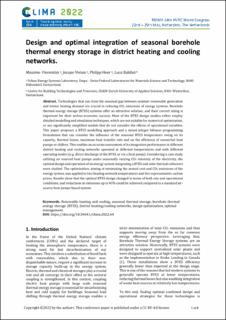Please use this identifier to cite or link to this item:
https://doi.org/10.21256/zhaw-25032Full metadata record
| DC Field | Value | Language |
|---|---|---|
| dc.contributor.author | Fiorentini, Massimo | - |
| dc.contributor.author | Vivian, Jacopo | - |
| dc.contributor.author | Heer, Philipp | - |
| dc.contributor.author | Baldini, Luca | - |
| dc.date.accessioned | 2022-05-30T13:47:25Z | - |
| dc.date.available | 2022-05-30T13:47:25Z | - |
| dc.date.issued | 2022-04-20 | - |
| dc.identifier.isbn | 978-94-6366-564-3 | de_CH |
| dc.identifier.uri | https://digitalcollection.zhaw.ch/handle/11475/25032 | - |
| dc.description | Conference Proceedings available at: https://proceedings.open.tudelft.nl/index.php/clima2022 | de_CH |
| dc.description.abstract | Technologies that can close the seasonal gap between summer renewable generation and winter heating demand are crucial in reducing CO2 emissions of energy systems. Borehole thermal energy storage (BTES) systems offer an attractive solution, and their correct sizing is important for their techno-economic success. Most of the BTES design studies either employ detailed modelling and simulation techniques, which are not suitable for numerical optimization, or use significantly simplified models that do not consider the effects of operational variables. This paper proposes a BTES modelling approach and a mixed-integer bilinear programming formulation that can consider the influence of the seasonal BTES temperature swing on its capacity, thermal losses, maximum heat transfer rate and on the efficiency of connected heat pumps or chillers. This enables an accurate assessment of its integration performance in different district heating and cooling networks operated at different temperatures and with different operating modes (e.g. direct discharge of the BTES or via a heat pump). Considering a case study utilizing air sourced heat pumps under seasonally varying CO2 intensity of the electricity, the optimal design and operation of an energy system integrating a BTES and solar thermal collectors were studied. The optimization, aiming at minimizing the annual cost and CO2 emissions of the energy system, was applied to two heating network temperatures and five representative carbon prices. Results show that the optimal BTES design changed in terms of both size and operational conditions, and reductions in emissions up to 43% could be achieved compared to a standard air-source heat pumps based system. | de_CH |
| dc.language.iso | en | de_CH |
| dc.publisher | TU Delft OPEN | de_CH |
| dc.rights | http://creativecommons.org/licenses/by/4.0/ | de_CH |
| dc.subject | Renewable heating and cooling | de_CH |
| dc.subject | Seasonal thermal storage | de_CH |
| dc.subject | Borehole thermal energy storage (BTES) | de_CH |
| dc.subject | District heating/cooling network | de_CH |
| dc.subject | Design optimization | de_CH |
| dc.subject | Optimal management | de_CH |
| dc.subject.ddc | 621.04: Energietechnik | de_CH |
| dc.title | Design and optimal integration of seasonal borehole thermal energy storage in district heating and cooling networks | de_CH |
| dc.type | Konferenz: Paper | de_CH |
| dcterms.type | Text | de_CH |
| zhaw.departement | Architektur, Gestaltung und Bauingenieurwesen | de_CH |
| zhaw.organisationalunit | Institut Bautechnologie und Prozesse (IBP) | de_CH |
| dc.identifier.doi | 10.34641/clima.2022.64 | de_CH |
| dc.identifier.doi | 10.21256/zhaw-25032 | - |
| zhaw.conference.details | 14th RHEVA HVAC World Congress, Rotterdam, The Netherlands, 22-25 May 2022 | de_CH |
| zhaw.funding.eu | No | de_CH |
| zhaw.originated.zhaw | Yes | de_CH |
| zhaw.publication.status | publishedVersion | de_CH |
| zhaw.publication.review | Peer review (Publikation) | de_CH |
| zhaw.title.proceedings | CLIMA 2022 The 14th REHVA HVAC World Congress | de_CH |
| zhaw.author.additional | No | de_CH |
| zhaw.display.portrait | Yes | de_CH |
| Appears in collections: | Publikationen Architektur, Gestaltung und Bauingenieurwesen | |
Files in This Item:
| File | Description | Size | Format | |
|---|---|---|---|---|
| 2022_Fiorentini-etal_BTES-in-district-heating-cooling-networks..pdf | 1.95 MB | Adobe PDF |  View/Open |
Show simple item record
Fiorentini, M., Vivian, J., Heer, P., & Baldini, L. (2022, April 20). Design and optimal integration of seasonal borehole thermal energy storage in district heating and cooling networks. CLIMA 2022 the 14th REHVA HVAC World Congress. https://doi.org/10.34641/clima.2022.64
Fiorentini, M. et al. (2022) ‘Design and optimal integration of seasonal borehole thermal energy storage in district heating and cooling networks’, in CLIMA 2022 The 14th REHVA HVAC World Congress. TU Delft OPEN. Available at: https://doi.org/10.34641/clima.2022.64.
M. Fiorentini, J. Vivian, P. Heer, and L. Baldini, “Design and optimal integration of seasonal borehole thermal energy storage in district heating and cooling networks,” in CLIMA 2022 The 14th REHVA HVAC World Congress, Apr. 2022. doi: 10.34641/clima.2022.64.
FIORENTINI, Massimo, Jacopo VIVIAN, Philipp HEER und Luca BALDINI, 2022. Design and optimal integration of seasonal borehole thermal energy storage in district heating and cooling networks. In: CLIMA 2022 The 14th REHVA HVAC World Congress. Conference paper. TU Delft OPEN. 20 April 2022. ISBN 978-94-6366-564-3
Fiorentini, Massimo, Jacopo Vivian, Philipp Heer, and Luca Baldini. 2022. “Design and Optimal Integration of Seasonal Borehole Thermal Energy Storage in District Heating and Cooling Networks.” Conference paper. In CLIMA 2022 the 14th REHVA HVAC World Congress. TU Delft OPEN. https://doi.org/10.34641/clima.2022.64.
Fiorentini, Massimo, et al. “Design and Optimal Integration of Seasonal Borehole Thermal Energy Storage in District Heating and Cooling Networks.” CLIMA 2022 the 14th REHVA HVAC World Congress, TU Delft OPEN, 2022, https://doi.org/10.34641/clima.2022.64.
Items in DSpace are protected by copyright, with all rights reserved, unless otherwise indicated.